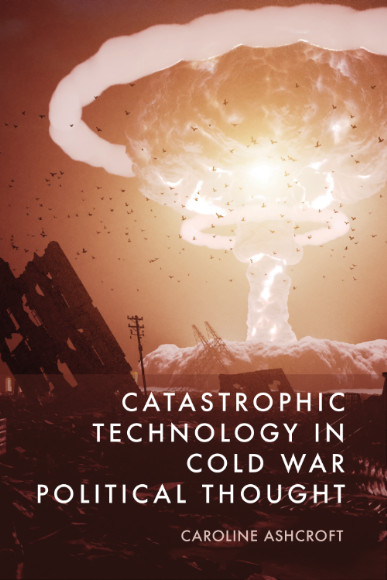
By Caroline Ashcroft
The relentless pace of technological change seems to be a characteristic feature of the twenty-first century, along with the question of how the risks entailed by such change can be mitigated or reliably brought within our control. But to many political thinkers of the mid-twentieth-century, technology also seemed to be the central transformation, and problem, of their time.
Despite the social, historical and intellectual changes of the past eighty years, as well as the changes to the state of technology itself, many of the concerns we hold today about contemporary technology are reflected in these earlier writings. Understanding how others have thought about the challenges of technology can help to gain some perspective on these questions.
Those who theorised the relation between politics, society and technology, like Günther Anders, Jacques Ellul, Hannah Arendt or Lewis Mumford, believed that technology was transforming the world, and the condition of humanity. ‘All history now takes place within the state of the world known as “technology”’, wrote Anders (481fn). ‘When technique enters into every area of life, including the human, it ceases to be external to man and becomes his very substance’, argued Ellul (p.6). Technology does not simply become increasingly prevalent in the world, it changes the world itself and the possibilities of the future. This can be seen in the influence of different kinds of technology: air travel brings the far away close to us; with television, politicians (amongst others) appear in the home of every individual.
This transformation was not seen to be benign. Technology did not just change the world, it threatened to destroy it, these theorists claimed. Most obviously, this describes the worst possibilities of nuclear power. For Hannah Arendt, who argued that nuclear power, wielded by humans, introduced formerly natural and universal processes into the human world, the technological transformation of the world was almost inevitably tilted towards catastrophe as humanity unleashed forces they could never hope to contain.
Many of those who held radically sceptical views about technology in the mid-twentieth century were deeply influenced by the mid-century experience of total, global war, the emergence of totalitarianism, and the development of nuclear weapons. Lewis Mumford claimed that the expansion of modern technology was driven by the ‘fusion heat’ of war (p.236). It carried the intonations of war with it; suggesting the character of modern technology as such was world-ending.
The idea that there is something about technology that inherently tends towards disaster on a massive scale is perhaps understandable in the wake of WWII and the Cold War nuclear standoff that succeeded it, yet is also unfeasibly deterministic in its pessimistic predictions. However, a version of this idea is reflected in a more specifically contemporary concern: the threat of global climate crisis. This too, is a world-ending threat, a threat driven fundamentally by technology, and the productivity and energy it uses and demands. This similarity is not purely coincidental.
Environmentalism was itself shaped by perceptions of catastrophic technology, particularly fears about the myriad risks entailed by nuclear power. A growing mutual interest can be seen between the political thinkers on technology and environmentalists in the 1960s and 1970s: environmental breakdown was evidence of the world-destructiveness of technology for the former, whilst the narratives of social and political catastrophe through technology chimed with concerns that the latter held about the broader impact of environmental change.
The historian Dipesh Chakrabarty has described the condition that emerges out of climate change as ‘like a universal that arises from a shared sense of catastrophe’ or a ‘negative universal history’ (p.222). This idea, which explicitly draws on the work of technological sceptics Walter Benjamin and Theodor Adorno, highlights the shared elements in environmental thinking and technological catastrophism: a problematic global universalism, the belief that we live in apocalyptic times, the unpredictability of the character of risk that modernity entails.
Given the historical confluence between the emergence of environmentalism and the increasing influence of an idea of ‘catastrophic technology’ in the mid-twentieth century, this overlap is not surprising. But it also gives us a different perspective on environmental catastrophe. Did narratives of technological catastrophe help to open our eyes to environmental threats? This seems likely. Does this therefore mean that the way in which we conceive of environmental threat, and the way to deal with environmental risk in politics, is also skewed by these influences? This too seems plausible. Certainly, the novelty of the current threat is not as novel as we might think, that is, the theorists of catastrophic technology felt themselves to live in times that were just as hopeless. That, in itself, might be cause for reflection about the possibilities of the future.
Further reading
Jacques Ellul, The Technological Society, trans. John Wilkinson (New York: Random House, 1964).
Dipesh Chakrabarty, ‘The Climate of History: Four Theses’ in Critical Inquiry, 35:2 (2009).
About the author
Caroline Ashcroft is a Lecturer in Politics at Harris Manchester College and Lady Margaret Hall, University of Oxford. She works in twentieth century political theory and history of political thought, particularly German and Anglo-American. She has previously published widely on Arendt’s political ideas, including Violence and Power in the Thought of Hannah Arendt (University of Pennsylvania Press, 2021). Her current research focuses primarily on the intersection of science and technology with politics in the twentieth century, particularly in the work of radical critics of technology and within environmental political theory and movements.
About the book
In the mid-twentieth century, a certain idea of technology emerged in the work of many influential political theorists: a critical, catastrophic concept of technology, entangled with the apocalyptic fears fuelled by two all-consuming world wars and the looming nuclear threat.
Drawing on the work of theorists such as Hannah Arendt, Jacques Ellul, Martin Heidegger and Herbert Marcuse, Catastrophic Technology in Cold War Political Thought explores the critical idea of technology as both a response to a dramatically changing world, and a radical political critique of Cold War liberalism.
Save 30% on Catastrophic Technology in Cold War Political Thought with code NEW30






